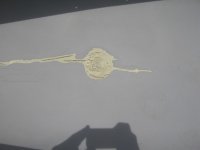Several years ago when I was outfitting my WW solo canoe (Mad River Outrage X), I made the mistake of using too much adhesive and/or not letting it dry sufficiently before placing the pedestal, knee pads, d-rings, etc. Things were fine for a few years, but over time the outer vinyl layer started to bubble and delaminate from the inner layers.
For the large area under the pedestal, I cut out the delaminated vinyl layer and replaced it with fiberglass cloth (e-glass), epoxy resin, and graphite powder. This looks like heck, but it has worked reasonably well and has lasted for several years.
Now it's time to fix the much smaller delaminated areas under the knee pads and d-rings. The vinyl is still in reasonable shape, it's just bubbled away from the inner layers. One recommendation I heard was to drill a small hole in each bubble and inject epoxy resin with a syringe. I'm wondering if G-Flex may work better than regular System Three or West System Resin as I've heard it's more flexible. I've never worked with G-Flex before. Is G-Flex thin enough to inject with a syringe?
Any other suggestions for how to repair these bubbles in the vinyl layer of Royalex? It doesn't have to be pretty as I'm not concerned with the aesthetics of a 15+ year old Royalex boat.
For the large area under the pedestal, I cut out the delaminated vinyl layer and replaced it with fiberglass cloth (e-glass), epoxy resin, and graphite powder. This looks like heck, but it has worked reasonably well and has lasted for several years.
Now it's time to fix the much smaller delaminated areas under the knee pads and d-rings. The vinyl is still in reasonable shape, it's just bubbled away from the inner layers. One recommendation I heard was to drill a small hole in each bubble and inject epoxy resin with a syringe. I'm wondering if G-Flex may work better than regular System Three or West System Resin as I've heard it's more flexible. I've never worked with G-Flex before. Is G-Flex thin enough to inject with a syringe?
Any other suggestions for how to repair these bubbles in the vinyl layer of Royalex? It doesn't have to be pretty as I'm not concerned with the aesthetics of a 15+ year old Royalex boat.



